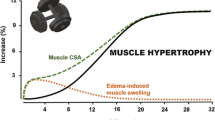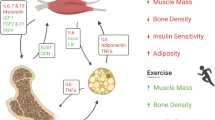Abstract
Functional β3-adrenoceptors have been found in skeletal muscle where they mediate metabolic oxidation and glucose utilization. Whether β3-adrenoceptors (ARs) also play any role in muscle protein metabolism still remains uncertain. By using rat L6 myocyte cultures, we found that CL316,243, a β3-AR selective agonist, at the concentration of 10−6 M for 24 h, induced a significant increase of skeletal muscle constitutive proteins such as H- and L-myosin and β-actin. Such effect was correlated to an increased expression of phosphorylated p70S6K that was significantly inhibited by β3-AR antagonist, SR 59230A, but not by β2-AR antagonist, ICI-118,551. The CL316,243-induced activation of p70S6K was markedly inhibited by wortmannin, a PI3K inhibitor, and rapamycin, a specific inhibitor of mTOR, suggesting a critical involvement of the PI3K–mTOR-p70S6K signaling cascade in the anabolic response of L6 cells to β3-AR agonist. Taken together, these results suggest that stimulation of β3-AR in skeletal muscle cells activates a specific signaling pathway leading to protein synthesis and, eventually, muscle growth.






Similar content being viewed by others
Abbreviations
- mTOR:
-
Mammalian target of rapamycin
- p70S6K :
-
p70S6 kinase
- 4E-BP1:
-
4E-binding protein 1
- eIF-4E:
-
Eukaryotic initiation factor 4E
- AR:
-
Adrenoceptor
- PI3K:
-
Phosphoinositol 3-kinase
- GAPDH:
-
Glyceraldehyde-3-phosphate dehydrogenase
- GPCR:
-
G protein-coupled receptors
- PTX:
-
Pertussis toxin
References
Anderson PT, Helferich WG, Parkhill LC, Merkel RA, Bergen WG (1990) Ractopamine increases total and myofibrillar protein synthesis in cultured rat myotubes. J Nutr 120:1677–1683
Audigane L, Kerfant BG, El Harchi A, Lorenzen-Schmidt I, Toumaniantz G, Cantereau A, Potreau D, Charpentier F, Noireaud J, Gauthier Rabbit C (2009) A relevant model for the study of cardiac β3-adrenoceptors. Exp Physiol 94:400–411
Bacqueville D, Déléris P, Mendre C, Pieraggi MT, Chap H, Guillon G, Perret B, Breton-Douillon M (2001) Characterization of a G protein-activated phosphoinositide 3-kinase in vascular smooth muscle cell nuclei. J Biol Chem 276:22170–22176
Board M, Doyle P, Cawthorne MA (2000) BRL37344, but not CGP12177, stimulates fuel oxidation by soleus muscle in vitro. Eur J Pharmacol 406:33–40
Bodine SC, Stitt TN, Gonzalez M, Kline WO, Stover GL, Bauerlein R, Zlotchenko E, Scrimgeour A, Lawrence JC, Glass DJ, Yancopoulos GD (2001) Akt/mTOR pathway is a crucial regulator of skeletal muscle hypertrophy and can prevent muscle atrophy in vivo. Nat Cell Biol 3:1014–1019
Bohorov O, Buttery PJ, Correia JH, Soar JB (1987) The effect of the β2-adrenergic agonist clenbuterol or implantation with oestradiol plus trenbolone acetate on protein metabolism in wether lambs. Br J Nutr 57:99–107
Braun T, Bober E, Buschhausen-Denker G, Kothz S, Grzeschik KH, Arnold HH (1989) Differential expression of myogenic determination genes in muscle cells: possible autoactivation by the Myf gene products. EMBO J 8:3617–3625
Caron MG, Lefkowitz RJ (1993) Catecholamine receptors: structure, function, and regulation. Recent Prog Horm Res 48:277–290
Chamberlain PD, Jennings KH, Paul F, Cordell J, Berry A, Holmes SD, Park J, Chambers J, Sennitt MV, Stock MJ, Cawthorne MA, Young PW, Murphy GJ (1999) The tissue distribution of the human beta3-adrenoceptor studied using a monoclonal antibody: direct evidence of the beta3-adrenoceptor in human adipose tissue, atrium and skeletal muscle. Int J Obes Relat Metab Disord 23:1057–1065
Emery PW, Rothwell NJ, Stock MJ, Winter PD (1984) Chronic effects of β2-adrenergic agonists on body composition and protein synthesis in the rat. Biosci Rep 4:83–91
Evans BA, Papaioannou M, Bonazzi VR, Summers RJ (1996) Expression of beta 3-adrenoceptor mRNA in rat tissues. Br J Pharmacol 117:210–216
Frost RA, Lang CH (2007) Protein kinase B/Akt: a nexus of growth factor and cytokine signaling in determining muscle mass. J Appl Physiol 103:378–387
Gauthier C, Leblais V, Kobzik L, Trochu JN, Khandoudi N, Bril A, Balligand JL, Marec HL (1998) The negative inotropic effect of β3-adrenoceptor stimulation is mediated by activation of a nitric oxide synthase pathway in human ventricle. J Clin Invest 102:1377–1384
Glass DJ (2005) Skeletal muscle hypertrophy and atrophy signaling pathways. Int J Biochem Cell Biol 37:1974–1984
Hannan KM, Brandenburger Y, Jenkins A, Sharkey K, Cavanaugh A, Rothblum L, Moss T, Poortinga G, McArthur GA, Pearson RB, Hannan RD (2003) mTOR-dependent regulation of ribosomal gene transcription requires S6K1 and is mediated by phosphorylation of the carboxy-terminal activation domain of the nucleolar transcription factor UBF. Mol Cell Biol 23:8862–8877
Hara K, Yonezawa K, Kozlowski MT, Sugimoto T, Andrabi K, Weng QP, Kasuga M, Nishimoto I, Avruch J (1997) Regulation of eIF-4E BP1 phosphorylation by mTOR. J Biol Chem 272:26457–26463
Hara K, Yonezawa K, Weng QP, Kozlowski MT, Belham C, Avruch J (1998) Amino acid sufficiency and mTOR regulate p70 S6 kinase and eIF-4E BP1 through a common effector mechanism. J Biol Chem 273:14484–14494
Hinkle RT, Hodge KM, Cody DB, Sheldon RJ, Kobilka BK, Isfort RJ (2002) Skeletal muscle hypertrophy and anti-atrophy effects of clenbuterol are mediated by the β2-adrenergic receptor. Muscle Nerve 25:729–734
Irace C, Scorziello A, Maffettone C, Pignataro G, Matrone C, Adornetto A, Santamaria R, Annunziato L, Colonna A (2005) Divergent modulation of iron regulatory proteins and ferritin biosynthesis by hypoxia/reoxygenation in neurones and glial cells. J Neurochem 95:1321–1331
Jackman RW, Kandarian SC (2004) The molecular basis of skeletal muscle atrophy. Am J Physiol Cell Physiol 287:834–843
Ji SQ, Orcutt MW (1991) Effects of the beta-adrenergic agonist isoproterenol on protein accretion, synthesis, and degradation in primary chicken muscle cell cultures. J Anim Sci 69:2855–2864
Kim YS, Sainz RD (1992) β-adrenergic agonists and hypertrophy of skeletal muscles. Life Sci 50:397–407
Kim YS, Sainz RD, Molenaar P, Summers RJ (1991) Characterization of β1- and β2-adrenoceptors in rat skeletal muscles. Biochem Pharmacol 429:1783–1789
Kimball SR, Farrell PA, Nguyen HV, Jefferson LS, Davis TA (2002) Developmental decline in components of signal transduction pathways regulating protein synthesis in pig muscle. Am J Physiol Endocrinol Metab 282:585–592
Kline WO, Panaro FJ, Yang H, Bodine SC (2007) Rapamycin inhibits the growth and muscle-sparing effects of clenbuterol. J Appl Physiol 102:740–747
Lynch GS, Ryall JG (2008) Role of β-Adrenoceptor signaling in skeletal muscle: implications for muscle wasting and disease. Physiol Rev 88:729–767
Ludolph DC, Konieczny SF (1995) Transcription factor families: muscling in on the myogenic program. FASEB J 9:1595–1604
Maltin CA, Hay SM, Delday MI, Lobley GE, Reeds PJ (1989) The action of the β-agonist clenbuterol on protein metabolism in innervated and denervated phasic muscles. Biochem J 261:965–971
McMillan DN, Noble BS, Maltin CA (1992) The effect of the β-adrenergic agonist clenbuterol on growth and protein metabolism in rat muscle cell cultures. J Anim Sci 70:3014–3023
Mersmann HJ (1998) Overview of the effects of β-adrenergic receptor agonists on animal growth including mechanisms of action. J Anim Sci 76:160–172
Miyazaki M, McCarthy JJ, Fedele MJ, Esser KA (2011) Early activation of mTORC1 signalling in respons to mechanical overload is independent of phosphoinositide 3-kinase/Akt signaling. J Physiol 7:1831–1846
Miyazaki M, Esser KA (2009) Cellular mechanisms regulating protein synthesis and skeletal muscle hypertrophy in animals. J Appl Physiol 106:1367–1373
Nader GA, McLoughlin TJ, Esser KA (2005) mTOR function in skeletal muscle hypertrophy: increased ribosomal RNA via cell cycle regulators. Am J Physiol Cell Physiol 289:1457–1465
Navegantes LC, Migliorini RH, do Carmo Kettelhut IC (2002) Adrenergic control of protein metabolism in skeletal muscle. Curr Opin Clin Nutr Metab Care 5:281–286
Navegantes LC, Resano NM, Baviera AM, Migliorini RH, Kettelhut IC (2006) CL316,243, a selective β3-adrenergic agonist, inhibits protein breakdown in rat skeletal muscle. Pflugers Arch 451:617–624
Park YC, Tomiyama Y, Hayakawa K, Akahane M, Ajisawa Y, Miyatake R, Kiwamoto H, Sugiyama T, Kurita T (2000) Existence of a beta3-adrenoceptro and its functional role in the human ureter. J Urol 164:1364–1370
Pascual M, Del Barrio AS, Portillo MP, Martinez JA, Larralde J (1993) Tissue protein turnover in animals treated with the mixed beta-agonist metaproterenol: influence of dose, route and pattern of administration. Biochimie 75:879–883
Pavoine C, Defer N (2005) The cardiac β2-adrenergic signalling a new role for the cPLA2. Cell Signal 17:141–152
Pette D (2001) Historical perspectives: plasticity of mammalian skeletal muscle. J Appl Physiol 90:1119–1124
Pette D (1980) Plasticity of muscle. de Gruyter, Berlin, New York
Reeds PI, Hay SM, Dorwood PM, Palmer RM (1986) Stimulation of muscle growth by clenbuterol: lack of effect on muscle protein biosynthesis. J Nutr 56:249–258
Reeds PJ, Hay SM, Dorward PM, Palmer RM (1988) The effect of beta-agonists and antagonists on muscle growth and body composition of young rats (Rattus sp.). Comp Biochem Physiol C 89:337–341
Reiter AK, Anthony TG, Anthony JC, Jefferson LS, Kimball SR (2004) The mTOR signaling pathway mediates control of ribosomal protein mRNA translation in rat liver. Int J Biochem Cell Biol 36:2169–2179
Ryall JG, Sillence MN, Lynch GS (2006) Systemic administration of β2-adrenoceptor agonists, formoterol and salmeterol, elicit skeletal muscle hypertrophy in rats at micromolar doses. Br J Pharmacol 147:587–595
Roberts SJ, Papaioannou M, Evans BA, Summers RJ (1999) Characterization of beta-adrenoceptor mediated smooth muscle relaxation and the detection of mRNA for beta1-, beta2- and beta3-adrenoceptors in rat ileum. Br J Pharmacol 127:949–961
Rouget C, Bardou M, Breuiller-Fouché M, Loustalot C, Qi H, Naline E, Croci T, Cabrol D, Advenier C, Leroy MJ (2005) Beta3-adrenoceptor is the predominant beta-adrenoceptor subtype in human myometrium and its expression is up-regulated in pregnancy. J Clin Endocrinol Metab 90:1644–1650
Rozec B, Gauthier C (2006) Beta3-adrenoceptors in the cardiovascular system: putative roles in human pathologies. Pharmacol Ther 111:52–73
Santamaria R, Bevilacqua MA, Maffettone C, Irace C, Iovine B, Colonna A (2006) Induction of H-ferritin synthesis by oxalomalate is regulated at both the transcriptional and post-transcriptional levels. Biochim Biophys Acta 1763:815–822
Soeder KJ, Snedden SK, Cao W, la Rocca GJ, Daniel KW, Luttrell LM (1999) The beta3-adrenergic receptor activates mitogen-activated protein kinase in adipocytes through a Gi-dependent mechanism. J Biol Chem 274:12017–12022
Tavernier G, Toumaniantz G, Erfanian M, Heymann MF, Laurent K, Langin D, Gauthier C (2000) β3-Adrenergic stimulation produces a decrease of cardiac contractility ex vivo in mice overexpressing the human β3-adrenergic receptor. Cardiovasc Res 59:288–296
von Manteuffel SR, Dennis PB, Pullen N, Gingras AC, Sonenberg N, Thomas G (1997) The insulin-induced signalling pathway leading to S6 and initiation factor 4E binding protein 1 phosphorylation bifurcates at a rapamycin-sensitive point immediately upstream of p70s6k. Mol Cell Biol 17:5426–5436
Yaffe D (1968) Retention of differentiation potentialities during prolonged cultivation of myogenic cells. Proc Natl Acad Sci USA 61:477–483
Yamaguchi O, Chapple CR (2007) Beta3-adrenoceptors in urinary bladder. Neurourol Urodyn 26:752–756
Yamazaki T, Komuro I, Zou Y, Kudoh S, Shiojima I, Hiroi Y, Mizuno T, Aikawa R, Takano H, Yazaki Y (1997) Norepinephrine induces the raf-1 kinase/mitogen-activated protein kinase cascade through both α1- and β-adrenoceptors. Circulation 95:1260–1268
Acknowledgments
We wish to thank Drs. M.L. Marciano, F. Tramontin, and A. Di Pascale for valuable assistance at different times in some of the experiments.
Author information
Authors and Affiliations
Corresponding author
Rights and permissions
About this article
Cite this article
Miniaci, M.C., Bucci, M., Santamaria, R. et al. CL316,243, a selective β3-adrenoceptor agonist, activates protein translation through mTOR/p70S6K signaling pathway in rat skeletal muscle cells. Pflugers Arch - Eur J Physiol 465, 509–516 (2013). https://doi.org/10.1007/s00424-012-1213-9
Received:
Revised:
Accepted:
Published:
Issue Date:
DOI: https://doi.org/10.1007/s00424-012-1213-9




